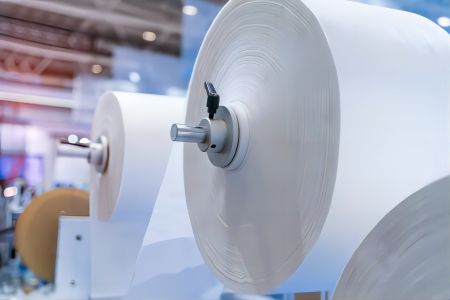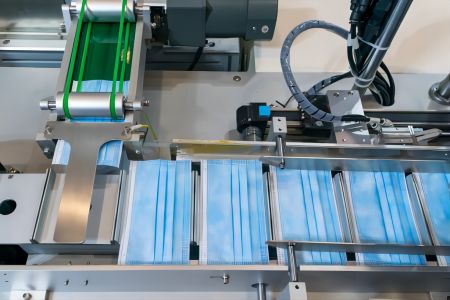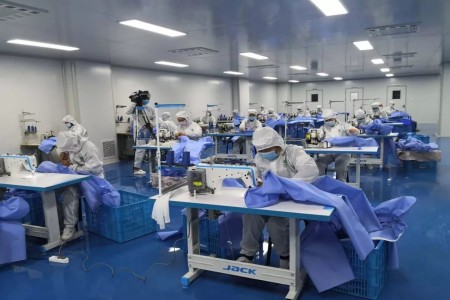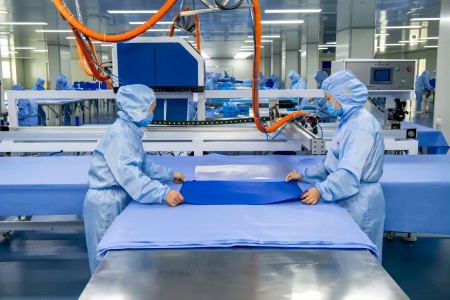2023/6/16

The Types of Non Woven Fabrics
As the world continues to grapple with the ongoing COVID-19 pandemic, face masks have become an essential part of our daily lives. Non-woven fabrics, in particular, have become a popular choice for face masks due to their effectiveness in filtering out harmful particles. Non-woven fabrics are made from fibers that are bonded together through various techniques, resulting in a material that is durable, lightweight, and comfortable to wear. However, not all non-woven fabrics are created equal. In this article, we'll take a closer look at the different types of non-woven fabrics used in face masks, including melt-blown, spun-bond, and SMS fabrics. Understanding the differences between these types of fabrics can help you make an informed decision when choosing a face mask that best suits your needs. So, without further ado, let's dive in!
Why are non-woven fabrics used for face masks?
Before we dive into the different types of non-woven fabrics used in face masks, let's first talk about why non-woven fabrics are used in the first place. Non-woven fabrics are an excellent choice for face masks because they are highly effective at filtering out airborne particles, including bacteria and viruses. These fabrics are also lightweight and breathable, making them comfortable to wear even for extended periods.
Non-woven fabrics are made by bonding fibers together through various techniques, including mechanical, thermal, and chemical bonding. The resulting material is strong, durable, and resistant to tearing, making it an excellent choice for face masks. In addition, non-woven fabrics are easy to produce in large quantities and can be manufactured in a range of colors, making them a versatile choice for face mask production.
Types of non-woven fabrics for face masks
Now that we understand why non-woven fabrics are used for face masks let's take a closer look at the different types of non-woven fabrics used in face masks.
Spunbond non-woven fabric
Spunbond non-woven fabric is one of the most commonly used types of non-woven fabrics in face masks. This fabric is made by spinning a polymer, such as polypropylene, into long, thin fibers. The fibers are then bonded together through a process called thermal bonding, which uses heat and pressure to melt the fibers together.
Spunbond non-woven fabric is lightweight and breathable, making it an excellent choice for face masks. In addition, it is strong and durable, which means that it can be used for extended periods without tearing or breaking down. Spunbond non-woven fabric is also resistant to water and chemicals, making it an excellent choice for face masks that need to be washed or sanitized regularly.
Meltblown non-woven fabric
Meltblown non-woven fabric is another commonly used type of non-woven fabric in face masks. This fabric is made by melting a polymer, such as polypropylene, and then extruding it through small nozzles to create long, thin fibers. The fibers are then blown onto a conveyor belt, where they are bonded together to create a sheet of fabric.
Meltblown non-woven fabric is highly effective at filtering out small particles, including bacteria and viruses. This fabric is able to filter out particles as small as 0.1 microns, making it an excellent choice for face masks that need to provide a high level of protection. In addition, meltblown non-woven fabric is lightweight and breathable, making it comfortable to wear for extended periods.
SMS non-woven fabric
SMS non-woven fabric is a type of non-woven fabric that is made by combining spunbond and meltblown fabrics. This fabric is made by first creating a layer of spunbond fabric and then adding a layer of meltblown fabric on top. The layers are then bonded together through a process called thermal bonding.
SMS non-woven fabric is highly effective at filtering out small particles, including bacteria and viruses. This fabric is able to filter out particles as small as 0.1 microns, making it an excellent choice for face masks that need to provide a high level of protection. In addition, SMS non-woven fabric is strong and durable, which means that it can be used for extended periods without tearing or breaking down.
Needle punched non-woven fabric
Needle punched non-woven fabric is a type of non-woven fabric that is made by punching thousands of tiny needles into a layer of fibers. This process causes the fibers to become entangled, creating a durable and strong fabric.
Needle punched non-woven fabric is commonly used in face masks because of its high durability and strength. This fabric is able to withstand extended use without tearing or breaking down, making it an excellent choice for face masks that need to be worn for extended periods. In addition, needle punched non-woven fabric is highly effective at filtering out particles, including bacteria and viruses.
Composite non-woven fabric
Composite non-woven fabric is a type of non-woven fabric that is made by combining two or more layers of different types of non-woven fabrics. This fabric is created by bonding the layers together through a process called thermal bonding.
Composite non-woven fabric is highly effective at filtering out particles, including bacteria and viruses. This fabric is able to filter out particles as small as 0.1 microns, making it an excellent choice for face masks that need to provide a high level of protection. In addition, composite non-woven fabric is strong and durable, which means that it can be used for extended periods without tearing or breaking down.
Which non-woven fabric is best for face masks?
The best non-woven fabric for face masks depends on a variety of factors, including the level of protection required, comfort, and durability. For face masks that need to provide a high level of protection, meltblown and SMS non-woven fabrics are excellent choices. These fabrics are highly effective at filtering out small particles, including bacteria and viruses.
For face masks that need to be comfortable to wear for extended periods, spunbond and needle punched non-woven fabrics are excellent choices. These fabrics are lightweight and breathable, making them comfortable to wear even for extended periods.
Conclusion
Non-woven fabrics are an excellent choice for face masks because they are highly effective at filtering out airborne particles, including bacteria and viruses. Understanding the differences between the different types of non-woven fabrics used in face masks can help you make an informed decision when choosing a face mask that best suits your needs. Whether you need a face mask that provides a high level of protection or one that is comfortable to wear for extended periods, there is a non-woven fabric that is right for you.
Hefei Hongwei Medical is a prominent disposable face mask manufacturer in China. With a focus on producing high-quality products, their specialty lies in the production of 3-ply non woven disposable face masks. These masks offer a protective barrier against harmful particles and are designed for single-use purposes. Hefei Hongwei Medical's commitment to quality and efficiency has made them a reliable supplier in the global market, providing customers with reliable and effective face masks.




 WhatsApp
WhatsApp
Send us your message
You can send an email asking for the price and detailed information of this product. We will reply you as soon as we receive your email